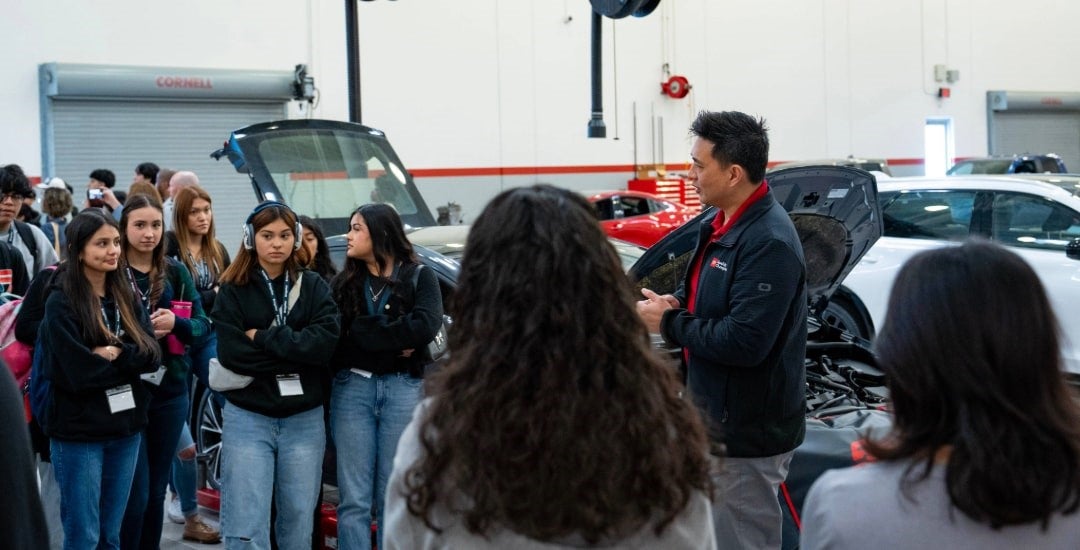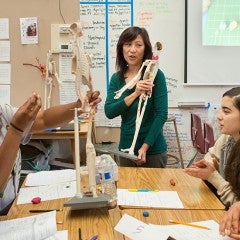But local workforce and school leaders want to make sure people already living in Houston aren’t left behind. Their challenge: training and developing locals to take advantage of the region’s growing economy.
Across the region, workforce advocates are laboring daily to take down barriers that keep residents from fully engaging in Houston’s job growth, with a particular focus on “middle-skill” jobs that require more than a high school diploma but less than a bachelor’s degree.
Common hurdles include access to career pathways for high schoolers, a lack of transparent information on local job demand and logistical obstacles to postsecondary training.
“There’s a huge skills gap,” said Victoria Chen, the co-founder and executive director of BridgeYear, a Houston-based nonprofit connecting young people with employment opportunities that do not require a four-year degree. “We don’t have enough skills or enough people to fill the demand.”
In Texas, 54% of available jobs are considered middle-skill, but only 45% of the labor force has the necessary credentials, according to a 2020 report by the National Skills Coalition. With a statewide labor force of over 15.8 million people, more than 1 million people would need additional training to fill available middle-skill jobs. Common jobs with a labor shortage include electricians, plumbers and registered nurses.
“When we think about economic mobility in our region, we have a lot of room to grow in terms of the educational differences,” Chen said. “The good news is there’s growth in the standard industries in Houston like construction, health care and energy. These are industries that power our economy, and they aren’t just recruiting four-year college graduates.”
The Houston metro area had about 3.5 million payroll jobs this May, according to Texas Workforce Commission data. In a longer-term forecast, the Houston-Galveston Area Council projects wage and salary jobs to exceed 4.8 million by 2050.
Education meeting industry
Preparing the middle-skill workforce often begins in Houston’s high schools, where students sometimes struggle to match their classes with a career pathway.
Research conducted by the Kinder Institute’s Houston Education Research Consortium shows that Houston-area students who participated in career and technical education, or CTE, pathways in high school had higher earnings if their coursework aligned with the industry they joined after graduation.
“We hear from college and career departments in school districts that they need more information about job demand and how it connects to the industry-based certifications that are approved by the Texas Education Agency,” said Erin Baumgartner, director of the Kinder Institute’s Houston Education Research Consortium.
In response, her team at the Kinder Institute created a public data dashboard to help district leaders, school staff and programs supporting postsecondary pathways improve their offerings and provide guidance to students about what occupations may lead to good-paying jobs.
At BridgeYear, staff members work with companies to identify alternative career pathways through early exposure, preparation and access to training programs outside the four-year bachelor’s degree. In the 2023-2024 school year, 82% of the students BridgeYear served were considered economically disadvantaged by the state and 86% identified as Black or Hispanic/Latino.
“A lot of our students still see four-year college as a possibility. It's just not their first step, or an accessible immediate next step after high school,” said Chen, a former teacher and college counselor. “A lot of our students are saying they need to make money before even thinking about paying for college.”
To prepare the workforce for the roles employers need filled, Chen said that industries and large corporations should be working with school districts, community-based organizations and community colleges.
“It starts with early exposure, and companies getting into the public school system in a meaningful way,” Chen said. “We should invest in career and technical education, and we need investment in our community college system and postsecondary training programs. Companies are missing out if they don’t see homegrown talent as a major talent source.”
At the state level, the Texas Education Agency is updating its guidelines for industry-based certification programs to better align with CTE programs. Even then, district-specific offerings can vary widely based on partnerships, funding and other capacity limitations.
‘Jobs that mobilize’
Careers that do not rely on a four-year degree are not just options for high school graduates. A national pilot program based in Houston has put middle-skill workers on a faster track to higher-paying roles and career advancement.
In March, the Burning Glass Institute published “Jobs That Mobilize: A Data-Driven Playbook for America’s Workforce.” The report, produced in collaboration with the Greater Houston Partnership and its UpSkill Houston initiative, suggested the interests of workers, employers, educators and community leaders must be aligned to create pathways for economic mobility.
The assessment said some of Houston’s workforce concerns included “overdependence on external talent recruitment, underutilization of local workforce potential, need for clearer pathways from low-wage positions to emerging tech roles, and a real risk of low-wage workers being displaced without clear pathways to emerging opportunities.”
The framework also recognizes that non-degreed workers “can be just as valuable as those with a college degree,” and it offers a way to see the growth potential across various jobs.
It identified 39 “jobs that mobilize” in the Houston area, from automotive body repairers, dental assistants, electricians and truck drivers to paralegals and legal assistants.
Some of the criteria were that jobs be in high-demand sectors, encourage career advancement, pay good wages and play a critical role in Houston’s long-term economic growth. Since 2024, Houston-area workers transitioning into “jobs that mobilize” have seen their wages increase by nearly 15%.
In a Houston Chronicle editorial, Matt Sigelman, president of the Burning Glass Institute, and Steve Kean, president and CEO of the Greater Houston Partnership, concluded that closing the skills gap is urgent. They argued that schools and workforce training should better acclimate to the job market, and policymakers also have a role in enabling a “skills-based ecosystem.”
“Houston can show what’s possible if we stop treating economic mobility as charity and start treating it as strategy,” they wrote. “The talent is here. The jobs are here. Bridging the gap isn’t optional — it’s the path to lasting growth and competitiveness.



